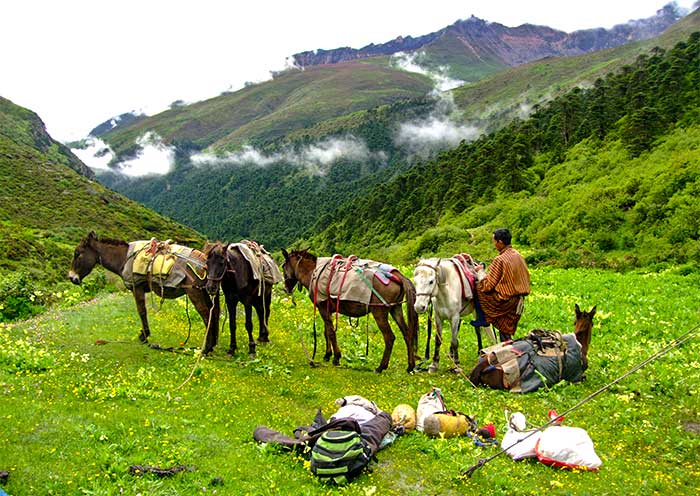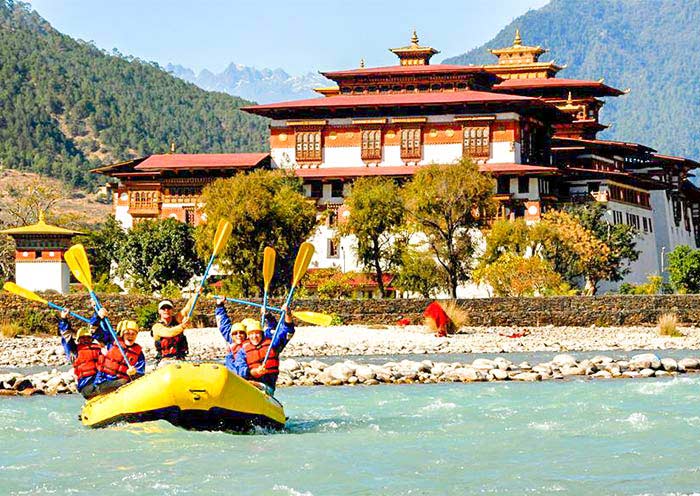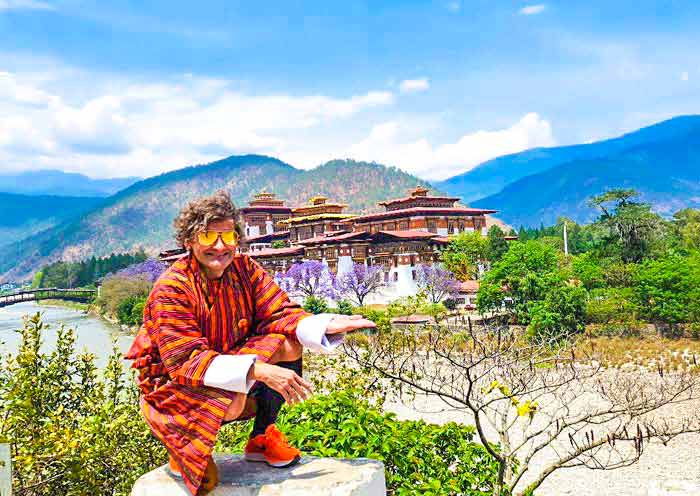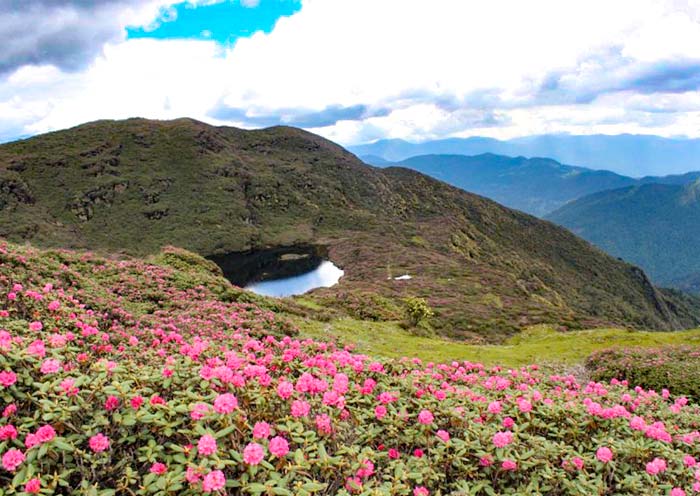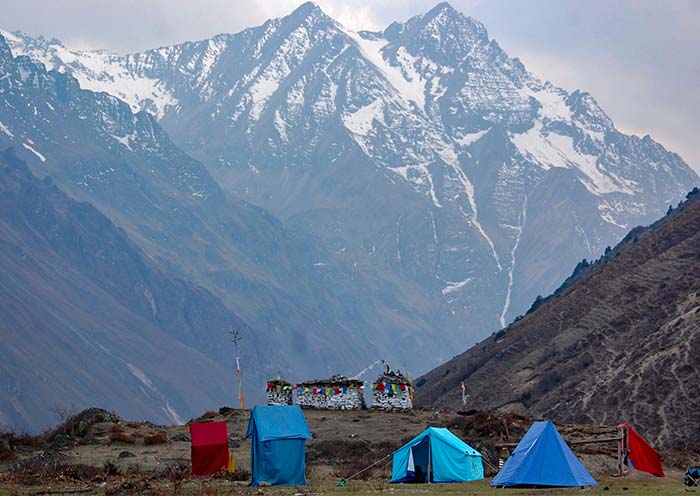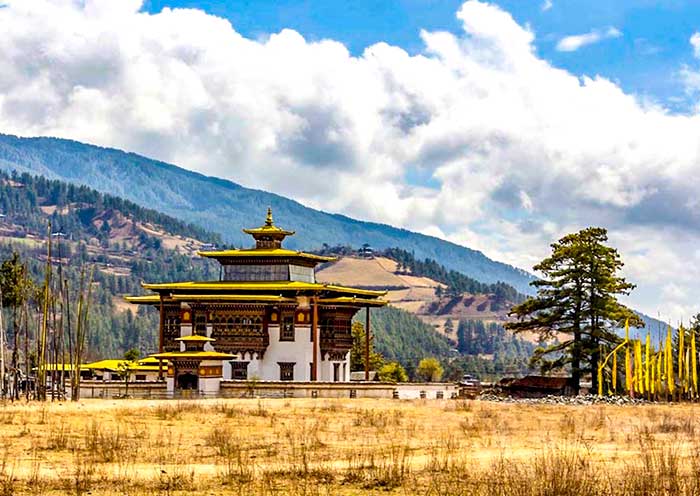- Highlights
- Itinerary
- Price
- Trip Notes
- Accommodation
- Photos
- Reviews
Experience one of the most classic trekking route - Druk Path Trek, a captivating 5-day adventure in Bhutan. This popular and moderately challenging trek takes you along the ancient trading route that connects the Paro and Thimphu valleys. Traverse high mountain passes and immerse yourself in breathtaking views of the mighty Himalayas, vibrant rhododendron forests, and serene high-altitude lakes.
Covering a distance of 56 kilometers, the trek reaches its pinnacle at an elevation of 4,110 meters. Journey through picturesque alpine yak pastures, enchanting blue pine forests, and untouched lakes of pristine beauty. Along the way, you'll have the opportunity to explore ancient villages, visit majestic dzongs (fortresses), and immerse yourself in the spiritual ambiance of lhakhangs (Buddhist temples). You will also have the best opportunity to explore the highlights of Paro, Thimphu, and Punakha during the combined 11-day tour in Bhutan.
Druk Path Trek Features:
5-day Classic Trek: This popular option provides a comprehensive experience of the entire route, with ample time to soak in the scenery and cultural encounters.
Medium Difficulty: While the trek features challenging inclines and high altitudes, it remains accessible for moderately fit individuals with good hiking experience.
Altitude Range: Prepare to encounter elevations ranging from 2,400 to 4,200 meters, with proper acclimatization crucial for a safe and enjoyable journey.
Best Time to Trek:(1) March to May: Enjoy pleasant temperatures, vibrant wildflowers, and clear skies. (2) September to November: Escape the monsoon season and witness the majestic autumn colors adorning the landscape.
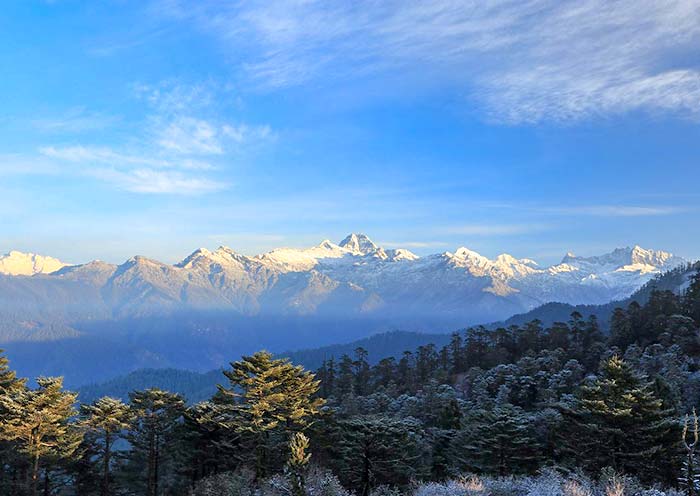
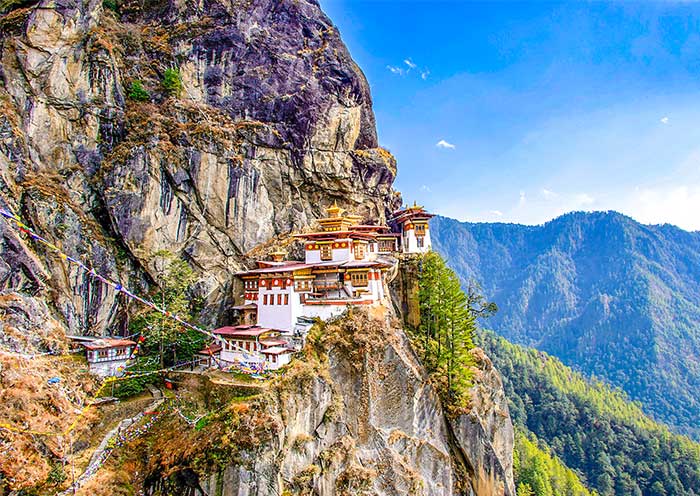
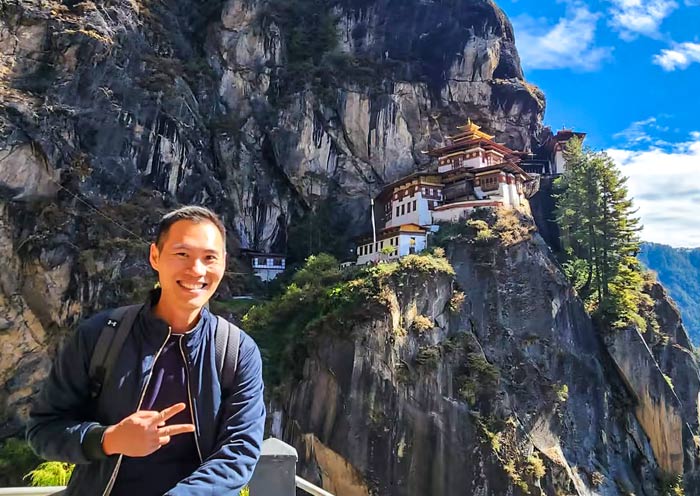
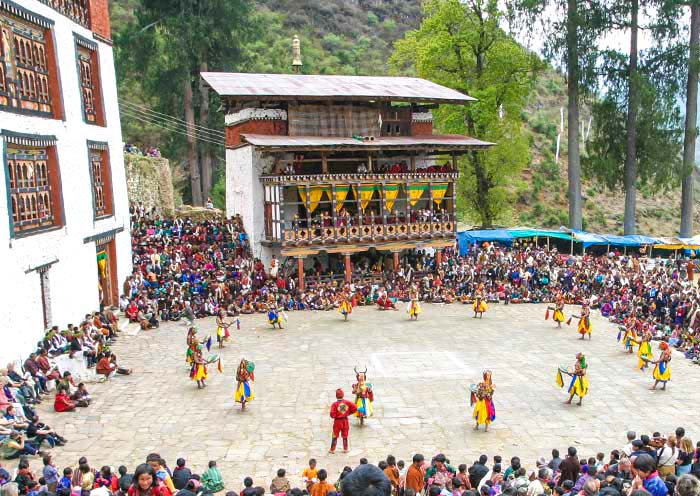
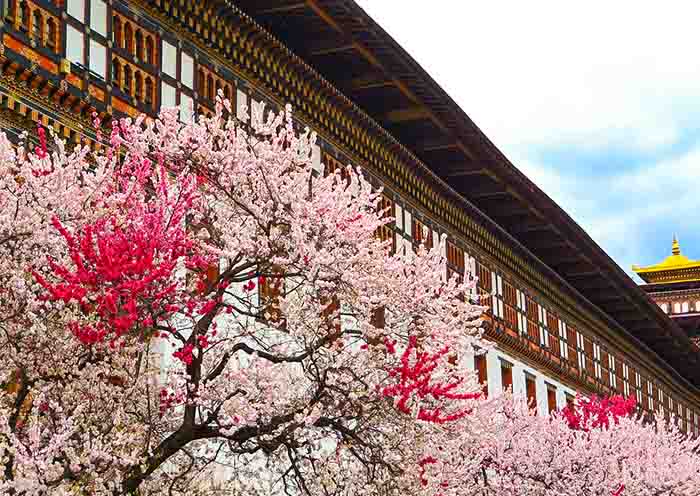
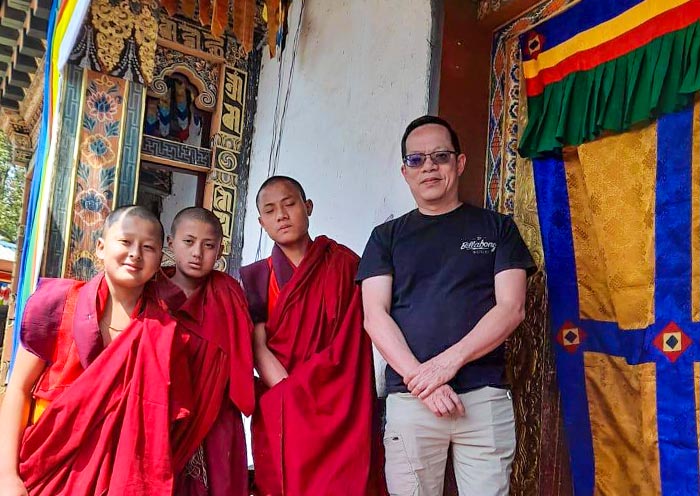
Itinerary at a Glance
Druk Path Trek (5 Days)
Jele Dzong, Jangchulakha, Jimeilang Lake, Janetsho Lake, Simkota, Phajoding Monastery
Paro (3.5 Days)
Tiger's Nest Monastery (Taktsang Goemba, Paro Taktshang), Kyichu Lhakhang, Rinpung Dzong (Paro Dzong), Bhutan National Museum (Ta Dzong)
Thimphu (1 Day)
Buddha Dordenma Statue, National Memorial Chorten, Tashichho Dzong (Thimphu Dzong), Motithang Takin Preserve, Folk Heritage Museum, Thimphu Local Market
Punakha (1.5 Day)
Dochula Pass, Chimi Lhakhang, Punakha Dzong
Itinerary Day by Day
Welcome to Bhutan, the Last Shangri La in Pristine Himalayan Kingdom. Take a deep breath and enjoy the refreshing breeze in the happy country where 71% of the land is covered with forests. Your guide and driver in Paro will greet you at Paro International Airport, Bhutan's only international airport.
Paro (2,270m) is the first city for most guests to reach Bhutan. It is known for Tiger's Nest which makes Paro a must-visit destination in Bhutan. For nature and culture lovers, Paro is a picturesque place that combines spirituality, natural beauty, and cultural heritage. You may have the chance to attend the colorful annual Paro Tshechu Festival if you visit Paro in early to mid-March. The festival falls on the 10th day of the second lunar month of the Bhutanese calendar. In some years, the festival might start slightly earlier, around March 10th or 15th. The festival celebrates the birthday of Guru Rinpoche, a revered figure in Bhutanese Buddhism.
You will not miss a stop at the Paro Airport Birds Eye View Point on the way to you hotel, which is a great spot to enjoy a panorama view of Paro Airport, Rinpung Dzong (Paro Dzong), National Museum (Ta Dzong), Paro Chu River, and the stunning Paro Valley itself. Don't forget to ask your guide for more fascinating information about this remarkable airport. Afterward, you can check in at your cozy hotel, where you can rest and acclimate yourself to any time difference.
Arrival Ideas:
Bhutan is situated between Tibet in China to the north and India to the south. To reach Bhutan, you can either travel by air to Paro International Airport, the country's only international airport, or by land through the entry points of Phuentsholing or Gelephu from India. Bhutan's national carrier, Druk Air, Bhutan Airlines, and other international airlines operate regular flights to Paro from major cities like Delhi (India), Kolkata (India), Bagdogra (India), Gaya (India), Guwahati (India), Dhaka (Bangladesh), Bangkok (Thailand), Kathmandu (Nepal), and Changi (Singapore). There are also some charter flights to Paro from Hong Kong (China) and Kuala Lumpur (Malaysia) on a seasonal basis. Around 30,000 people arrive at Paro Airport every year.
Kind Reminds:
1. You can contact us to book your flight to Paro and land directly in Bhutan.
2. Visitors of all nationalities, except those from India (require a permit), require an E-visa (40USD/pax) before entering Bhutan. All nationalities are welcome to visit Bhutan, and there are no specific restrictions on granting visas to enter the country.
3. Visitors from India are able to apply for a permit but are required to hold an Indian passport or an Indian voter ID card.
4. Visitors from Bangladesh and the Maldives also require a visa, which can be applied for and approved in advance of travel or upon arrival in Bhutan.
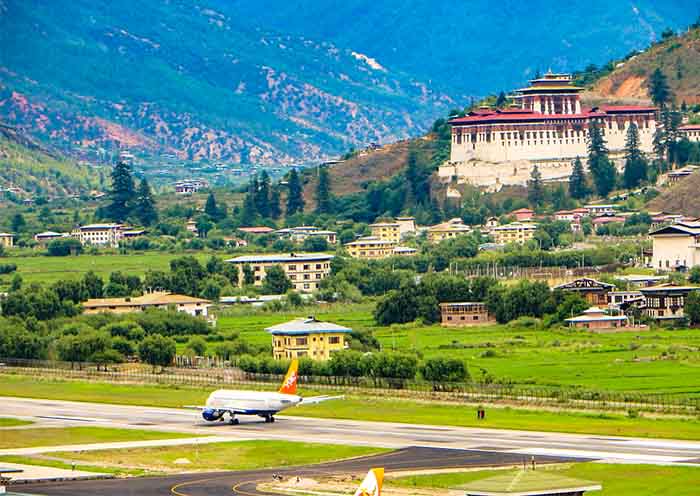
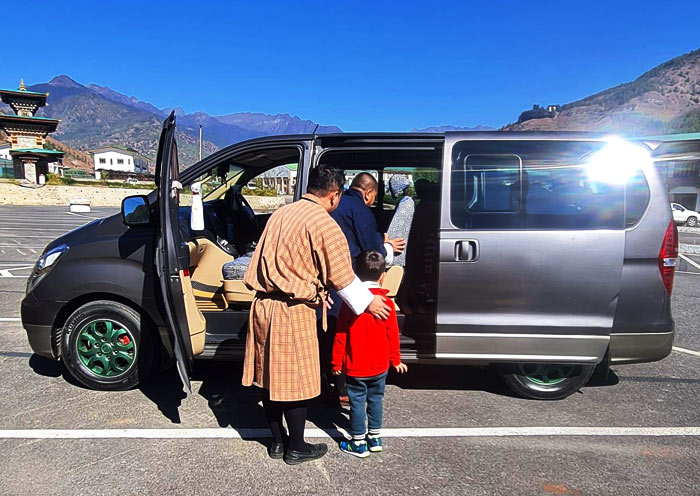
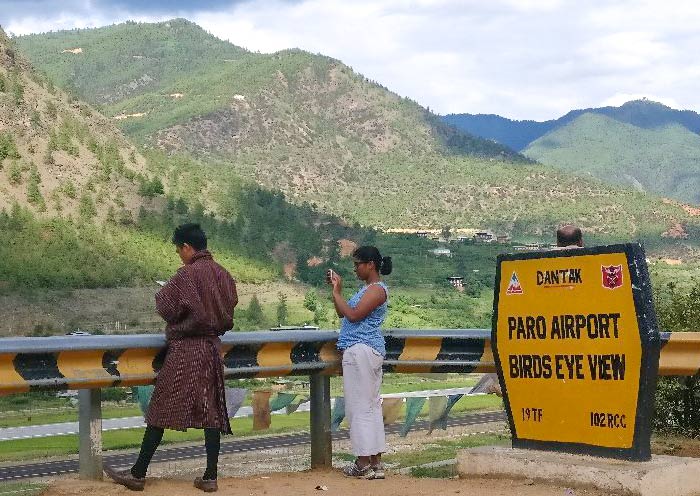
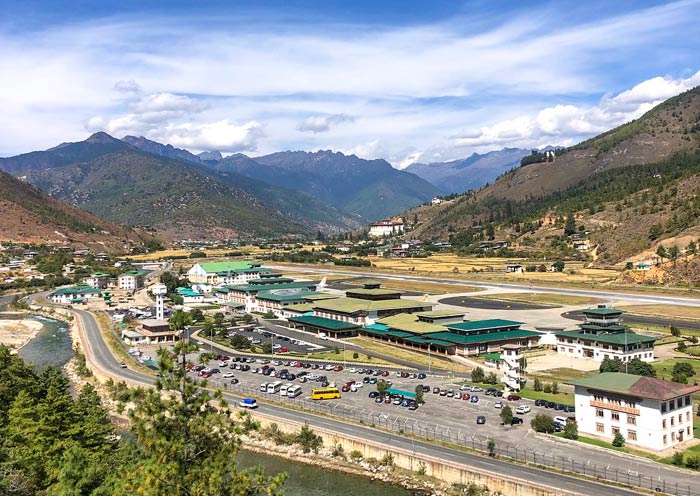
This morning, you will enjoy the exciting hiking tour to Tiger's Nest, the landmark of Bhutan and the most famous holy monastery in the country. It is about a 12km drive (over 0.5 hours) from Paro City to the start point of the Tiger's Nest hike route.
Usually, it may take about 2.5 hours to reach Tiger's Nest Monastery (Paro Taktsang) on foot. The entire Tiger's Nest Hike takes around 5 to 6 hours, with about 4.8km of uphill trekking and about 4.8km of downhill walking. You have the option to rent a horse at the designated place if you prefer. Riding a horse (self-payment required) takes about 1.5 hours to reach the halfway point on the mountainside. From there, you need to say goodbye to your horse and hike for another 1.5 hours to reach the Tiger's Nest Monastery. At the halfway point, there is a Taktsang Cafeteria where you can have a buffet lunch and enjoy coffee and tea. What is more, it is the first viewpoint where you can look up Tiger's Nest Monastery, the incredible religious site of Buddhists. As the viewing position ascends, the outline of Tiger's Nest Monastery becomes increasingly clear. On the journey ahead, you can enjoy the hike in Bhutan’s forest and will see more and more prayer flags and prayer wheels, left behind by the Bhutanese people who come here to worship. You will also have a panoramic view of the beautiful Paro Valley below. If you visit in April, you will have the opportunity to see the high-altitude rhododendrons blooming, creating a stunning display of red clouds amidst the mountains.
Then, you will stand right opposite the Taktsang Goemba (Tiger's Nest Monastery) and admire Bhutan's most iconic cultural landmark, which is renowned as one of the world's top ten super monasteries. The Tiger's Nest (3,120m) is situated on the side of a cliff at a height of 900m above the Paro Valley (2,270m). According to legend, the Indian sage Guru Padmasambhava (Guru Rimpoche, the founder of the Nyingma school of Tibetan Buddhism and the builder of the first monastery in Tibet - Samye Monastery) arrived at the location of Tiger's Nest Monastery in the 8th century. It is said that he rode a tigress and subdued demons before spending 3 months meditating in the mountain caves here. This eventually led to the formation of the present-day Tiger's Nest Monastery. Throughout history, this place has been considered a sacred site by Buddhist luminaries. However, it wasn't until 1692 that the current structure of Tiger's Nest Monastery took shape. In 1998, a devastating fire caused significant damage, but it was reconstructed in 2005, closely resembling the original architectural design. If you are interested you can hike into the monastery to explore more (no photo inside). Today, Tiger's Nest Monastery, one of the most visited tourist attractions in Bhutan, is revered as the holiest pilgrimage site for Bhutanese people to visit at least once in a lifetime.
After completing the Tiger's Nest hike, you will proceed to Drukgyal Dzong, where you will have the opportunity to catch a glimpse of Mount Jomolhari (7,570m). Known as the "Mountain Goddess" and the tallest mountain in Bhutan, Mt Jomolhari is considered a sacred abode for deities and spirits, earning the title of "Sacred Mountain". Know as the Fortress of the Victorious Drukpa, Drukgyal Dzong was believed to have been built in 1646 by Zhabdrung Ngawang Namgyal who is the unifier and founder of the Bhutanese nation-state. The building was used as an administrative center until 1951 when a fire caused by a butter lamp destroyed it. In April 2016, to celebrate the birth of the Dragon Prince, Gyalsey His Royal Highness Jigme Namgyel Wangchuck, as well as to commemorate the arrival of Zhabdrung Ngawang Namgyel to Bhutan in 1616 AD and the birth year of Guru Rinpoche, then Prime Minister Tshering Tobgay announced that the dzong will be restored and reinstated to its former glory upon the command of His Majesty King Jigme Khesar.
Then, it is time to visit Kyichu Lhakhang, also known as the Temple of the Thousand-armed and Thousand-eyed Avalokiteshvara. It is one of the 108 Buddhist temples built by King Songtsen Gampo in the 7th century (around 659 AD), and it is believed to have been constructed to subdue the left leg of the Tibetan witch. Kyichu Lhakhang is also one of the oldest Tibetan Buddhist temples in Bhutan and serves as a venue for important celebrations of the Bhutanese royal family. In the main hall of Kyichu Lhakhang, you can see the revered statue of an eight-year-old Shakyamuni Buddha, believed to have been created during the same period as the Jowo statue in the Jokhang Temple in Lhasa, Tibet. It is considered a national treasure of the Kingdom of Bhutan. Apart from housing many precious historical artifacts and Buddhist scriptures, the temple also enshrines the relic stupa of Dilgo Khyentse Rinpoche (1910-1991), a renowned master of the Nyingma tradition. Additionally, there is a piece of iron chain forged by Tangtong Gyalpo, who was the former head of the four major Tibetan Buddhist schools and is known as the Iron Bridge Living Buddha and the father of Tibetan opera.
If time permits and you are interested, you can also visit a local farmhouse, which provides a fascinating glimpse into the lifestyle of a farmer. Finally, head back to Paro for an overnight stay.
Optional Bhutan Paro Experiences:
1. Bhutan Traditional Hot Stone Bath (1 hour).
2. Lighting butter lamps for blessings at Kyichu Lhakhang (108 lamps).
3. Dinner with the Bhutanese Culture Dance Show.
Kind Reminds:
1. The best time to visit Tiger's Nest is from March to May and from October to December. After noon, the monastery will be hidden in the shadow of the cliffs, so it's recommended to depart early if you want to capture good photos.
2. Tiger's Nest offers horse riding services to go uphill, but the horse ride is only available up to a designated point. From there, you still need to hike to reach the monastery. When descending, you must walk the entire way as horse riding services are not provided.
3. Mobile phones and backpacks are not allowed inside Tiger's Nest Monastery. Personal belongings can be stored at the entrance. If you wish to light butter lamps, make sure to have some cash ready before storing your belongings.
4. Along the way, you may encounter stray dogs. Please be mindful, give them space, and avoid disturbing them.
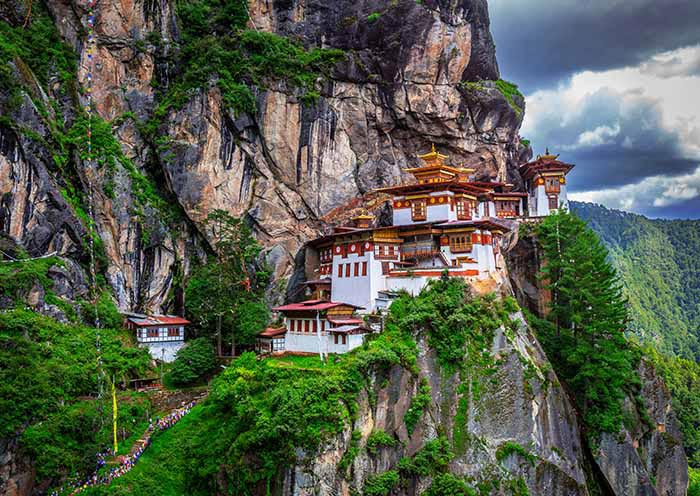

10 km, 4-5 hours | 1,003 ascent, 10 m descent | camp at 3,480 meters
On the first day of the trek, the distance isn't too far, but it mainly involves ascending paths with an elevation gain of over 1,000 meters. We start at the trailhead near the Paro National Museum, which is situated at an altitude of 2,470 meters. After walking along a dirt road for 30 minutes, you'll come across the first shortcut, which offers several paths to bypass the mountain. About 40 minutes later, you'll pass by Kuenga Choeling Lhakhang at 2650 meters. Continuing uphill for an hour, you'll reach Damchena, where you'll find a stone house and apple orchard at an altitude of 2880 meters. A 10-minute walk from there will lead you to a mani wall (a stone wall inscribed with scriptures) and the Damche Gom campsite at 2,985 meters, nestled in a forest clearing.
Following this, there is a long and gradual climb through a forest covered in golden moss, eventually reaching a nomad campsite before the Jele La pass at an altitude of 3540 meters. Descending from the pass, marked by cairns and dilapidated stupas, you'll arrive at a picturesque camping site on a meadow surrounded by rhododendron forests, just below Jele Dzong.
During your visit to Jele Dzong (3,490m), perched on a whaleback ridge, you'll find mostly ruins and a Lhakhang with a statue of Buddha Sakyamuni. On a clear day, the breathtaking views of Paro town far below and Mount Jomolhari (7,315m) are awe-inspiring. Overnight camping will be at 3480m.
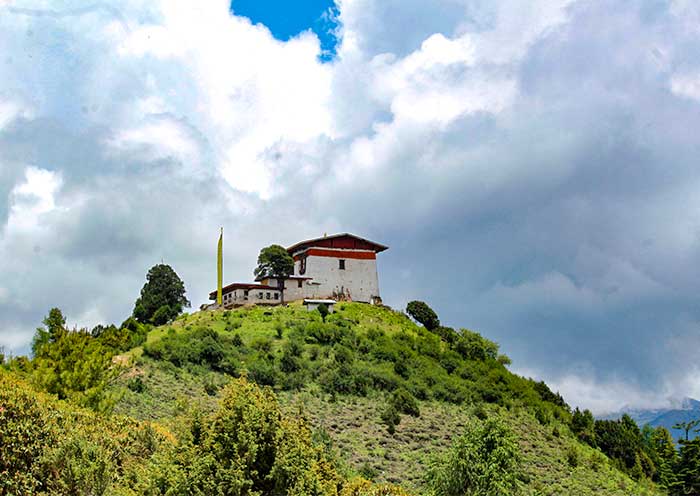

10km, 4 hours | 300km ascent camp at 3,780 meters
On the second day of the trek, we begin our hike with a gentle ascent, followed by a descent below the ridgeline. As we walk along the trail, you will be surrounded by lush alpine forests and vibrant rhododendrons, creating a picturesque and enchanting environment. Keep an eye out for yak herders who may be tending to their animals in the area. Throughout the journey, you will be treated to awe-inspiring views of Jomolhari and other majestic snow-capped mountains. During the daytime, the melodious calls of monal pheasants will serenade you, adding a delightful soundtrack to the experience. Continuing our upward climb, we eventually reach Jangchulakha (3,780m), a stunning pasture where yak herders graze their animals. From this vantage point, you will be rewarded with breathtaking vistas of the Himalayan range. Our campsite for the night will be nestled in a tranquil yak pasture, providing a peaceful retreat near the hillside.
11km, 4-5 hours | 400 ascent, 300 descent | camp at 3,880 meters
On the third day of the trek, we will make our way to Jimelang Tsho. On clear days, there is a view of Mount Jomolhari and the 6,989-meter-high Jichu Drakye Peak, believed to be the incarnation of the guardian deity of Paro. The lower-altitude route descends from Tshokham into the upper section of the Bemang Rong Valley and then ascends through the yak pastures of Langrithang.
Along the way, a solitary prayer flag flutters in the wind. After a 30-minute walk, you will reach a meadow and then descend through a rhododendron forest, passing to the left of a small hill adorned with prayer flags. About an hour away from the campsite, you will cross the narrow Langye Ja La pass (meaning "ox camel pass") at an altitude of 4,070 meters. You can climb an additional 50 meters to the top of a small peak and enjoy the spectacular 360-degree panoramic view.
The steep downhill path with rugged rocks can present a challenge in finding solid footing. After passing a herder's hut near a cliff, you will climb 80 meters to a pass where you can see Mount Jomolhari. Looking down into the Chumpu Ney Valley, you will spot the yellow-roofed house of Chumpu Ney, a famous pilgrimage site that houses a statue of the Dorje Phagmo deity. Continuing for another 5 minutes, you will see Jimilang Tsho in the distance below. Descend to a saddle for a lunch break, then continue ascending along the ridges, taking a final glimpse of Mount Jomolhari at an altitude of 4,180 meters from a stupa. The next part is a steep 30-minute descent, leading directly to the shores of Jimelang Tsho Lake. Another 5-minute walk will take you to a delightful camping spot at the end of the lake at an altitude of 3,885 meters.
Jimilang Tsho means "Sand Bull Lake". The name comes from a bull that emerged from the lake and joined the herd of a herder family who grazes their cattle here every summer. The lake is also renowned for its large-sized trout, which were introduced to the lake in the 1970s.
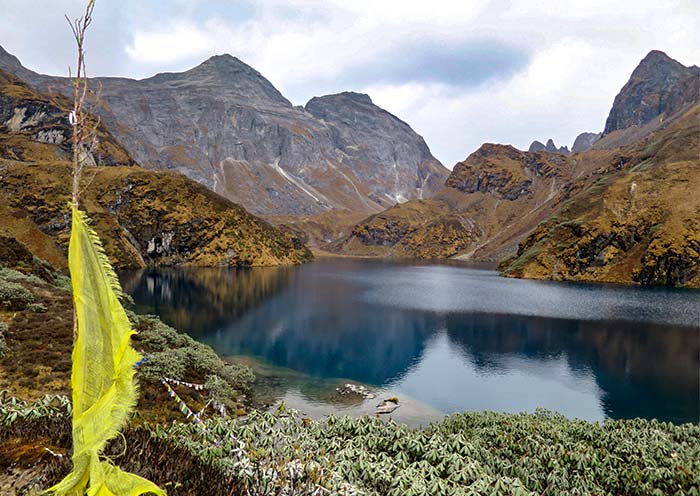
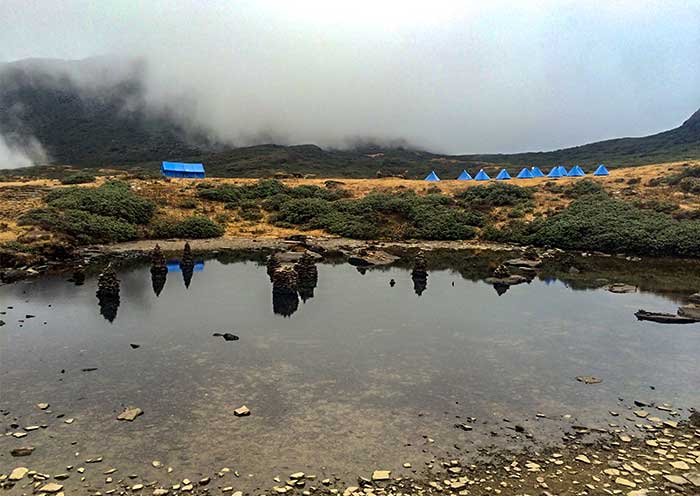
11km, 4 hours | 270 ascent | camp at 4,110 meters
On the fourth day of the trek, the trail begins by ascending from the lower part of the lake, passing through a yellow rhododendron forest, until it reaches a ridge at an altitude of 4,010 meters above sea level. After crossing the ridge, it descends to a solitary rock shelter. Continuing along the ridge, you will encounter prayer flags at 4,050 meters, providing a magnificent view of Janye Tsho Lake. From there, you will descend to the lakeside yak pasture at an altitude of 3,880 meters. Following that, you will ascend again, gradually turning to the right, until you reach another ridge at 4,150 meters. This elevated point offers a panoramic view of Simkotra Tsho Lake. Descend to an area with stone ruins and finally arrive at the camping site situated at an altitude of 4,100 meters above sea level.
14km, 7 Hours | 100m ascent, 1,800m decent
Today, our journey commences with a gradual ascent towards the Phume La Pass, the highest point of our trek at an elevation of 4,210 meters. From this elevated position, we are treated to breathtaking vistas of Mt. Gangkar Puensum, an impressive peak towering at 7,570 meters. It is noteworthy that this majestic summit is not only the highest in Bhutan but also holds the distinction of being the tallest unclimbed peak worldwide.
After immersing ourselves in the awe-inspiring scenery, the trail begins its descent, meandering through juniper trees, until we arrive at a campsite located near a community hall close to Phajoding Monastery. Continuing from Phajoding, the path gently slopes downhill all the way to Thimphu, passing through a forested area predominantly adorned with blue pine trees. Taking our time and maintaining a relaxed pace, we will reach Thimphu with ample time to spare, allowing us to relish an afternoon city tour.
If circumstances allow and you share an interest in Bhutan's national animal, we have the option to visit the Motithang Takin Preserve situated near Thimphu city. There, we can have the opportunity to observe the unique creature known as the takin, believed to have been created by the legendary figure Drukpa Kunley, also known as the Divine Madman.
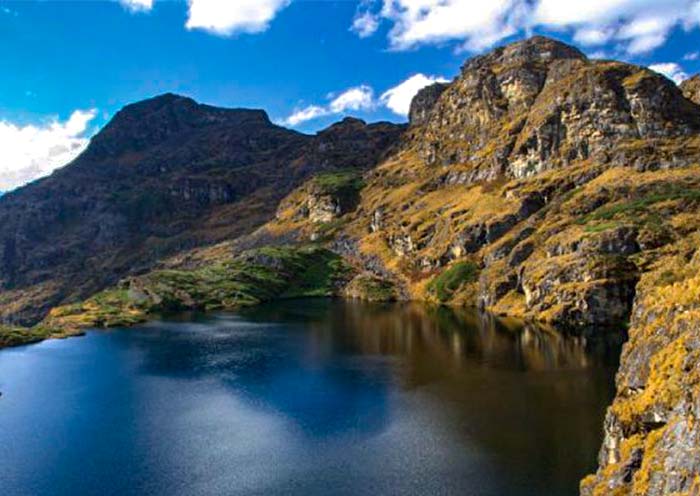
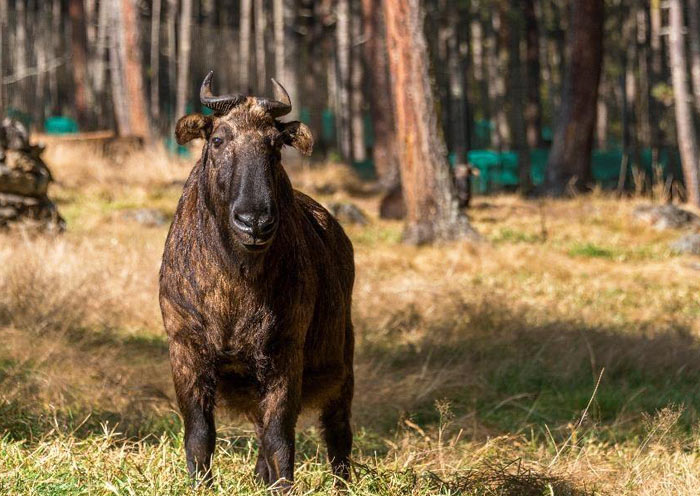
After breakfast, you'll set out to explore Thimphu's highlights. First, visit the iconic landmark of Thimphu city - the Buddha Dordenma Statue (Buddha Point), which is the largest sitting Shakyamuni statue in the world. Completed in 2015, the statue embodies an ancient prophecy of radiating happiness and peace throughout the world. In addition to admiring its impressive height of 51.5 meters, constructed of bronze and gilded in gold, you will also be able to see 125,000 smaller Buddha statues placed within it. Moreover, from this vantage point, you can enjoy a magnificent view of the Thimphu Valley.
As the largest city in Bhutan, Thimphu lacks traffic lights and a railway system. When you enter the city, you can visit the National Memorial Chorten and experience it as the locals do. It is customary to follow the footsteps of the Bhutanese people and perform a clockwise kora (circumambulation) around the Chorten while offering prayers. This will provide you with numerous opportunities to engage with the locals and learn about their daily lives, as well as their philosophy on happiness.
The National Memorial Chorten is the most visited landmark in Thimphu. Constructed in 1974 in memory of the Third King, His Majesty Jigme Dorji Wangchuk (known as the Father of Modern Bhutan), by his mother, it reflects the late king's vision of promoting world peace and prosperity. The Chorten follows a Tibetan-style architecture and is adorned with remarkable paintings and intricate sculptures. You can observe the traditional stupa design, featuring a pyramidal pillar topped with a crescent moon and sun.
Sure, you should not miss the visit to Tashichho Dzong (Thimphu Dzong), which has served as the seat of the government since 1952. This magnificent fortress-like structure is located on the western bank of the Wang Chu River. It seamlessly integrates with the entire valley and stands as the ultimate center of power in Bhutan. It houses the offices of the current reigning monarch, the Fifth King (Jigme Khesar Namgyel Wangchuck), as well as the ministries of internal affairs and finance. Additionally, it serves as the residence of the spiritual leader of Bhutan, the Je Khenpo, and hosts the central religious institutions of the country. During the summer season, the Je Khenpo resides in the Thimphu Dzong, while in the winter season, they relocate to Punakha Dzong. Walking around the Dzong, you will discover that it is an impressively large structure surrounded by well-kept lawns and beautiful gardens. Tashichho Dzong has two main entrances. One entrance leads to the administrative section in the south, while the other, situated in the north, grants access to the monastic quarter where the Thimphu Tshechu festival and masked dances are performed. (Note: The opening hours of Thimphu Dzong are from 9 AM to 5 PM on weekdays and from 10 AM to 4 PM on weekends. It is required to have a tour guide accompany you for a visit to the Dzongs. Before entering for a visit, security checks are conducted.)
After that, pay a visit to the Bhutan Post Office Headquarters (General Post Office) first for fully functional stamp printed with a self-portrait. This post office is known for housing the world's largest photo book and an intriguing collection of Bhutanese stamps. It is the only place where you can obtain personalized stamps featuring your own face. (Open hours for the post office: Weekdays: 9AM - 5PM; Saturdays: 9 AM - 1 PM; Closed on Sundays).
Afterward, you can further explore the Folk Heritage Museum. The museum was established in 2001 through the initiative of Her Majesty Ashi Dorji Wangmo Wangchuck, the Queen Mother of Bhutan. It is housed in a three-storied, 19th-century traditional house, offering visitors a glimpse into the traditional Bhutanese lifestyle. The museum showcases artifacts from rural households, including a collection of typical household objects, tools, and equipment.
The day concludes with a visit to the Thimphu Local Market, also known as the Centenary Farmers Market, the biggest and brightest in the country. As you wander through the aisles, you'll be surrounded by a kaleidoscope of colors, sounds, and smells that make the market come alive. You might find yourself drawn to the sections overflowing with fresh fruits and vegetables, or perhaps the aromatic spices and herbs will catch your attention. Don't miss the opportunity to taste some of the local cheese or the array of dried meats, a staple in the Bhutanese diet. Beyond food, explore the areas dedicated to traditional Bhutanese textiles and handicrafts. It's a chance to pick up souvenirs. If luck is on your side, you may even witness a thrilling game of archery in the Changlingmithang stadium. Note: The market typically operates on weekends, from Friday to Sunday evening.
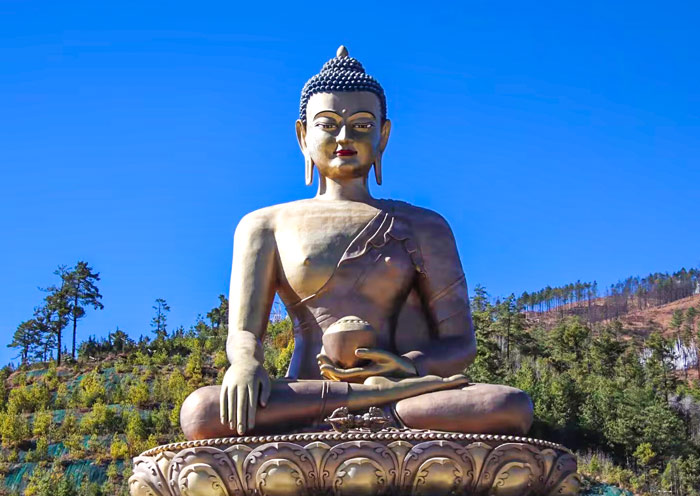
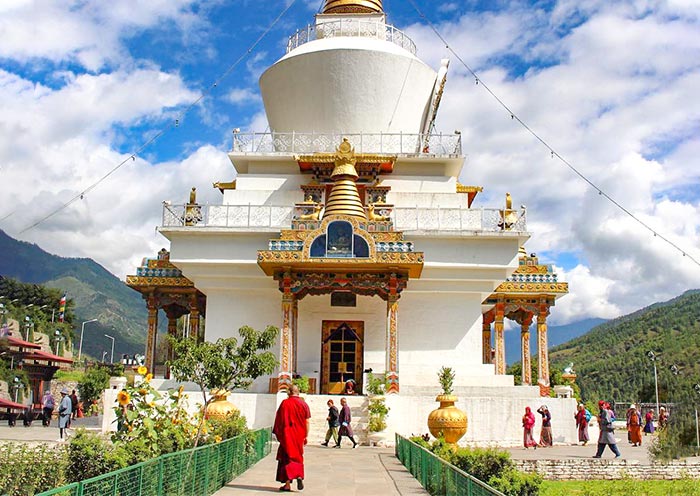
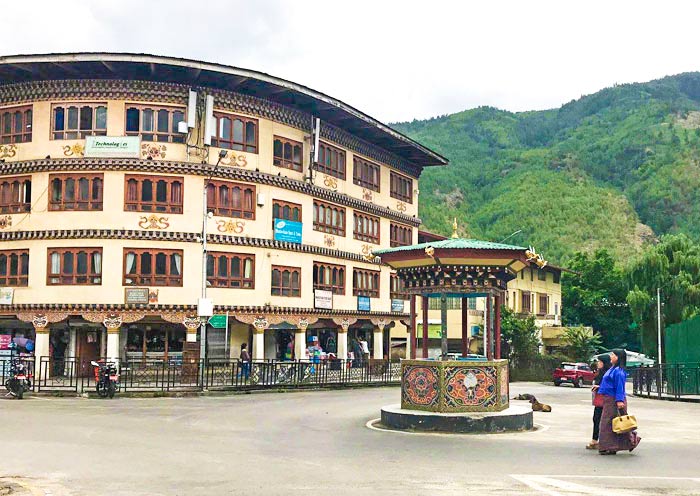
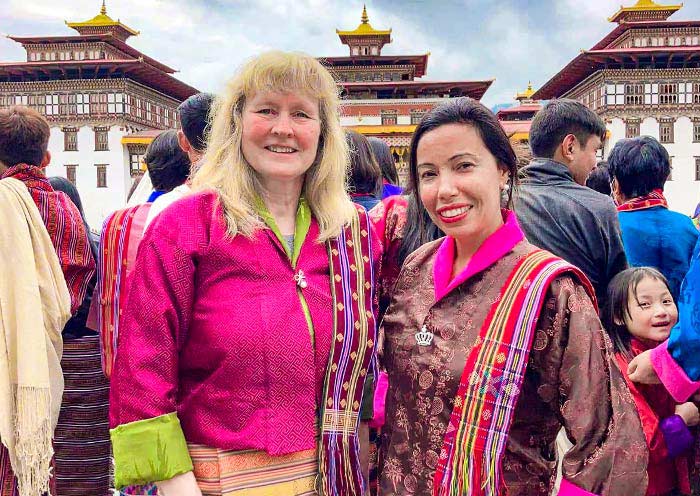
Today, you will travel from Thimphu to Punakha via Dochula Pass (74km, about 2.5 hours). This trip is more than just a drive; it is a voyage through changing altitudes and diverse landscapes, offering a visual spectacle. Starting from the higher altitude and cooler climate of Thimphu (2,300m), the drive takes you along the national highway, ascending through the majestic Dochula Pass (3,120m). Upon crossing the pass, you'll descend into the warm and verdant Punakha Valley (1,330m).
En route, you will stop at Dochula Pass (Dochu La Pass), renowned as one of the most beautiful mountain passes in Bhutan. If weather permits, you will be treated to a breathtaking panoramic view of the Himalayas, including Bhutan’s highest mountain peak, Mt. Gangkar Puensum (7,570m). You will have the delightful option to savor the view while enjoying a cup of coffee in the picturesque cafeteria. At the Dochu La Pass summit, you will encounter the 108 memorial chortens (Buddhist shrines) and clusters of prayer flags fluttering in the wind, creating an ambiance of tranquility and spirituality. These chortens (stupas), known as Druk Wangyal Khang Zhang Chortens, were constructed as a memorial to honor the Bhutanese soldiers who lost their lives in the battle against Assamese insurgents from India, and also as an offering for global peace.
Then, your journey continues towards Punakha. Along the way, you will take a hike to Chimi Lhakhang (Chime Lhakhang), which is highly recommended as a culture shock tour. As you stroll through rice paddies and a charming settlement adorned with painted houses and numerous craft shops, you will eventually reach Chimi Lhakhang (Fertility Temple). Constructed by the cousin of Drukpa Kunley, the temple was built to commemorate the victory of Drukpa Kunley (Mad Saint & Divine Madman) over the demon of Dochu La using his "magic thunderbolt of wisdom "(phallus). That is why you can see the symbol of the phallus scattered throughout. Lama Drukpa Kunley was adored by the local people due to his unconventional teaching methods of Buddhism, which involved singing, humor, and an exaggerated manner often intertwined with sexual overtones. Chime Lhakhang is renowned as a sanctuary of fertility, and many childless women sought blessings from the lamas at the monastery. It is believed that these couples often find success in conceiving soon after their visit. If you are lucky, you may encounter the monks there blessing pilgrims or women who wish to conceive by tapping their heads with a 25cm wooden phallus. In Bhutan, it is common for local people to utilize the phallus symbol to ward off the evil eye and deter malicious gossip.
After that, drive to Punakha city, the old capital of Bhutan before 1955. It is located at the confluence of the Mo Chhu (Mother River) and Pho Chhu (Father River). Dominating the river junction is the magnificent Punakha Dzong, the winter residence of Je Khenpo (head abbot of Bhutan) and about 1,000 monks. Occasionally, you'll spot monks draped in red robes passing by, their rhythmic chanting and prayers echoing in the air. Punakha Dzong, the second oldest and second largest Dzong in Bhutan serving administrative and monastic functions holds a legendary tale. It is said that Guru Rinpoche (Padmasambhava) prophesied the arrival of a person named Namgyal built a Dzong on a hill resembling an elephant. In 1637, Shabdrung Ngawang Namgyel, the unifier of Bhutan, received a divine vision guiding him to construct a Dzong at this site. All of Bhutan’s kings have been crowned here and In 2011, the Dzong bore witness to the royal wedding ceremony of His Majesty Jigme Namgyel Wangchuck, the 5th King of Bhutan, as he married Queen Jetsun Pema. As the most beautiful Dzong in Bhutan, if you visit in April, you won’t miss the stunning violet blossoms of the jacaranda tree outside Punakha Dzong. The jacaranda typically blooms from late March to early May, During this time, the grounds of Punakha Dzong transform into a magical carpet of purple under the clear blue skies, creating a truly breathtaking sight. If you visit during the Punakha Tshechu Festival, you can enjoy the mesmerizing masked dances and witness the exhibition of a large thangka depicting the Zhabdrung (Shabdrung, the father of Bhutan) once a year. You can have fun with locals who flood here dressed in Bhutan’s national attire, with men wearing Gho and women wearing Kira.
After crossing the Bazam Bridge, you can walk inside the Punakha Dzong and take your time to admire this stunning example of Bhutanese Dzong architecture which was built of stone, pounded mud, and a considerable amount of timber (without nails, written plans or designs). There is a six stories central tower called utse standing in the yard of the Punakha Dzong. As the highest architecture within the Dzong, utse houses the most sacred temples and shrines and contains important religious artifacts, thangkas, statues, and texts. This Dzong has three docheys (courtyards) instead of the usual two. The first (northern) courtyard is for administrative functions and houses a huge white Victory Chorten and Bodhi tree. The second courtyard houses the monastic quarters and is separated from the first by the utse. In this courtyard, there are two halls; one of Ugyen Wangchuck (the King of Bhutan) and another hall where the King was decorated in 1905 with the Order of the Knight Commander of the Indian Empire by John Claude White. In the third (southernmost) courtyard is the temple where the remains of the Pema Lingpa (a treasure revealer, Five Terton Kings) and Shabdrung (founder of Tshechu Festival and Bhutan National Dress) are preserved. At the south end, there is the kunrey, or "hundred-pillar" assembly hall with exceptional murals that depict the life of Buddha.
Overnight in Punakha and get ready for your next day's trip.
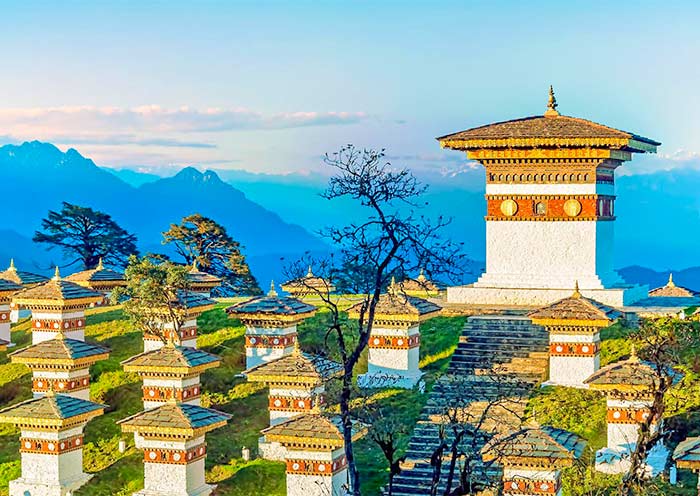
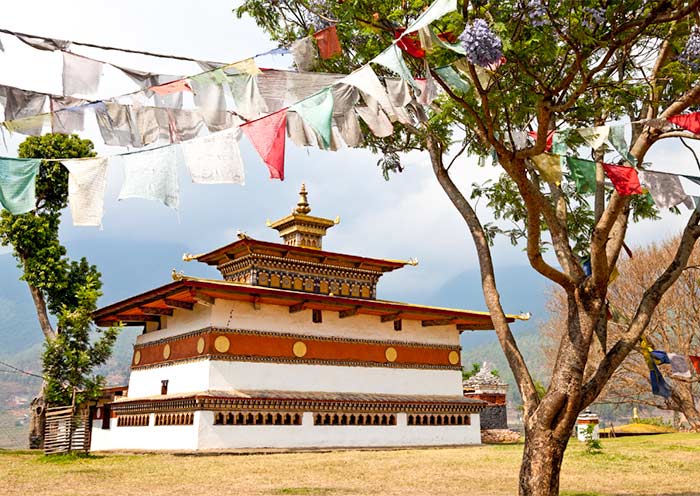
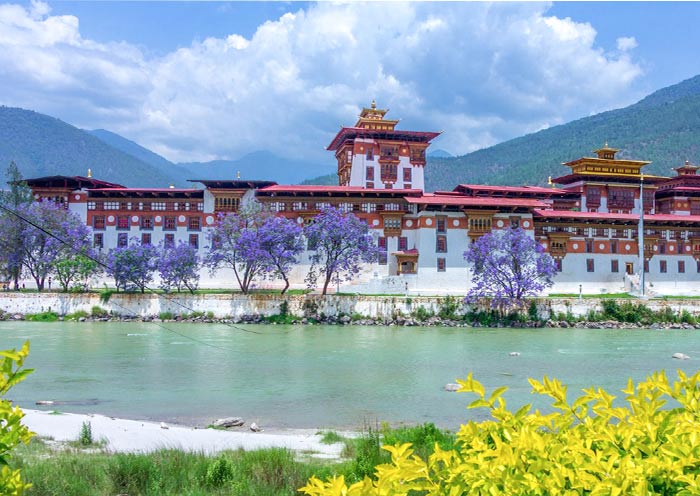
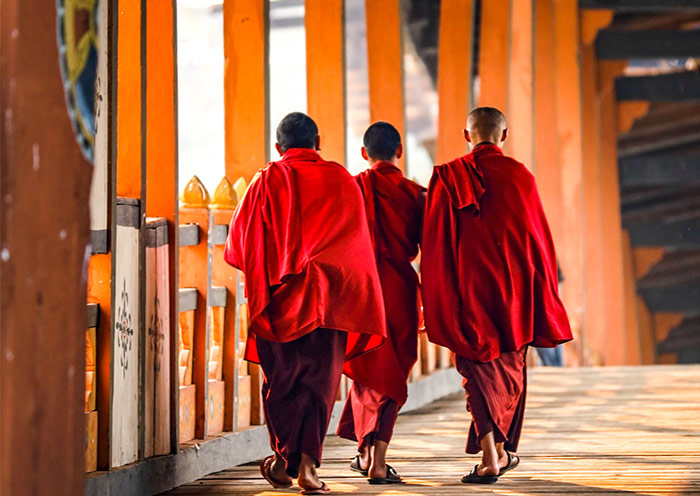
After breakfast, you will begin your return journey from Punakha to Paro (110km, about 3-3.5 hours). After arrive in Paro, you will have the opportunity to visit Paro Dzong (Rinpung Dzong). This magnificent fortress stands tall and proud, serving as a beacon of history and culture in Bhutan. Rinpung Dzong was constructed in 1646 by Shabdrung Ngawang Namgyal (1594-1651), a pivotal figure in Bhutanese history who is revered as the founder of the modern Bhutanese state and a national hero. His enduring legacy continues to shape the country's identity and cultural landscape. Located near the pristine Paro Chu River, Paro Dzong can be accessed via a traditional wooden cantilever bridge, providing you breathtaking panoramic views of the enchanting Paro Valley.
If you hike a little further, you will reach the Bhutan National Museum (Ta Dzong), which holds the distinction of being Bhutan's tallest building. Originally constructed in 1649 as a watchtower overlooking the Paro Dzong, it was later transformed into the National Museum of Bhutan in 1968. At the museum, you can immerse yourself in a rich collection of ancient artifacts such as pottery, armor, thangkas, masks, stamps, photographs, statues, costumes, relics, stone axes, and religious paintings.
Note: Please note that Paro Dzong is open from 9 AM to 5 PM on weekdays and from 10 AM to 4 PM on weekends. If you can't make it to the opening hours, we suggest visiting the Paro Local Market instead. It's a place where locals and tourists alike come to shop for traditional Bhutanese handicrafts, textiles, jewelry, and other local produce. It offers a glimpse into the daily life and culture of Bhutan.
Stay overnight in Paro.
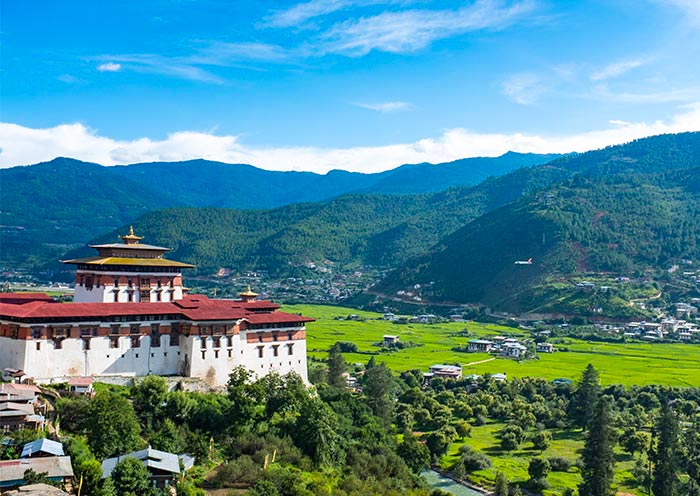
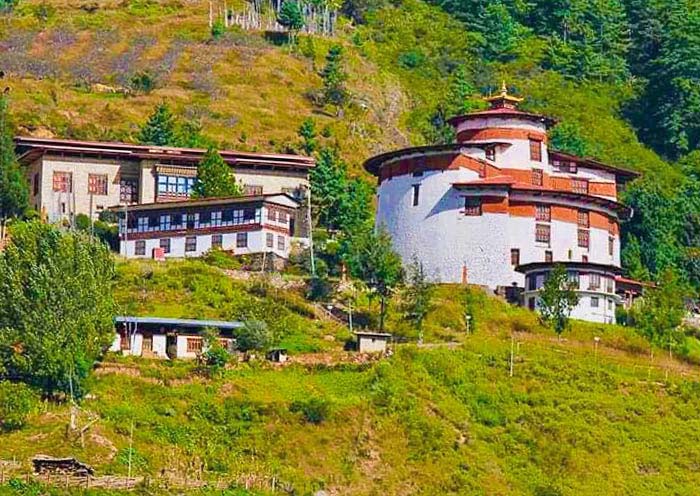
Happiness is a place, wish you had gotten your happiness philosophy from the beautiful Himalayan country with us. It is time to end your 11-day Bhutan Trekking Tour. Your guide will escort you to Paro International Airport for your flight to your next destination.
Extension Ideas:
1.If you prefer to travel longer in Bhutan, you can extend your trip to other highlighted parts of Bhutan, such as Gangtey, Haa, and Bumthang.
2.If you plan to continue exploring neighboring countries in Southeast Asia, the Himalaya countries, or Asia, such as Thailand, Nepal, India, or China, don't hesitate to let us know. We can customize your itinerary and assist with travel arrangements.
Thank you for choosing Asia Odyssey Travel (AOT) for your Bhutan tour, we are always here working for you and hope to see you again for your next trip to China/Asia. Safe journey!
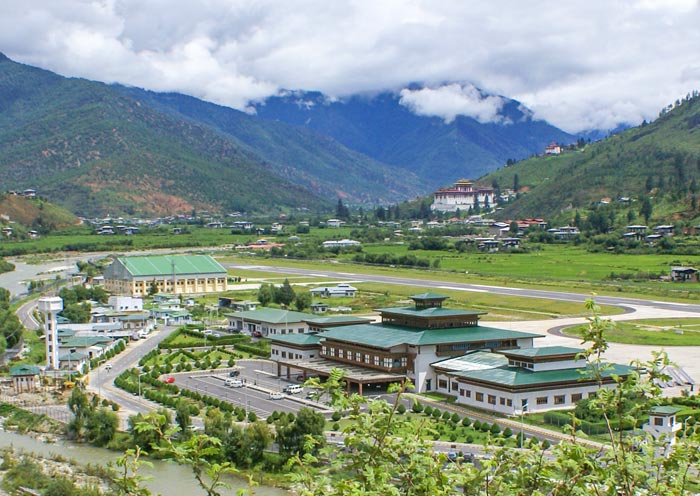
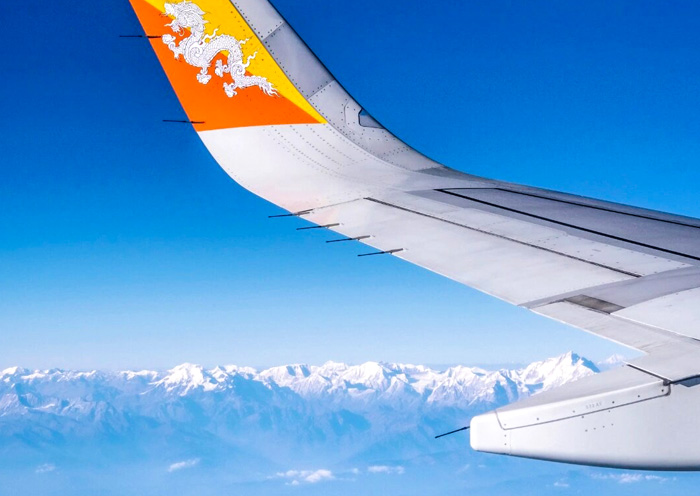
Price: What’s Included & What’s Excluded
What’s Included:
What’s Excluded:
Important Travel Tips for Visiting Bhutan
Please note that full payment of the tour fee is required 30 days before the departure date. The tour fee should be transferred to the account of the Royal Bank of Bhutan. Once the payment is received, the Bhutanese government will process your visa.
A Bhutan Group Tour typically involves traveling with a group of 1 to 12 travelers. During the tour, you will follow a set schedule and participate in activities as planned by us. The hotel arrangements for Group Tours in Bhutan are based on a 3-star level, making them more budget-friendly compared to private tours. We offer 9 group tours ranging from 4 to 11 days in duration.
On the other hand, a Bhutan Private Tour is designed to cater to your specific preferences and requirements. With a Private Tour, you have greater control over the itinerary, allowing you to customize it according to your interests and preferred pace. Additionally, you can choose the hotel condition, whether it be luxury or budget, based on your preferences. We offer Bhutan private tours with different themes, and you can choose from tours lasting 3 to 11 days.
The ideal seasons for traveling in Bhutan are from March to November, when the weather is most suitable for visitors. During the off-peak season, which lasts from December to February, it is winter in Bhutan. Daytime temperatures hover around 15 degrees Celsius, and at night, they drop below freezing. From June to September, it is the summer and rainy season, with daytime temperatures around 23 degrees Celsius and nighttime temperatures around 15 degrees Celsius.
On the other hand, the peak travel periods are from March to May and from September to November.
Bhutanese cuisine prominently features chili as its main ingredient, with most dishes incorporating cheese, potatoes, and chili. Vegetables primarily consist of legumes and tubers. If you have any dietary restrictions or special meal requirements, please inform us during the tour registration process so that we can make appropriate meal arrangements.
In the Paro region of Bhutan, staple foods include rice, buckwheat, corn, and red rice. Chili and dairy products are commonly used as accompaniments. One of the most famous traditional dishes is Ema Datshi, which consists of chili with cheese. While beef, lamb, and pork are popular meats, it's important to note that Bhutan follows Buddhist principles of non-violence and does not slaughter animals within the country. Most of the meat available in the market is imported from neighboring India and primarily caters to tourists. Beverage options include black tea, butter tea, rice wine, and beer.
Hotel Conditions for Your Bhutan Tour
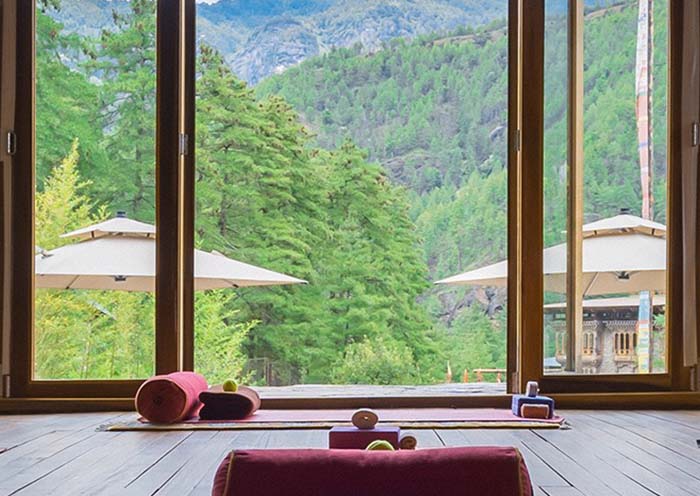

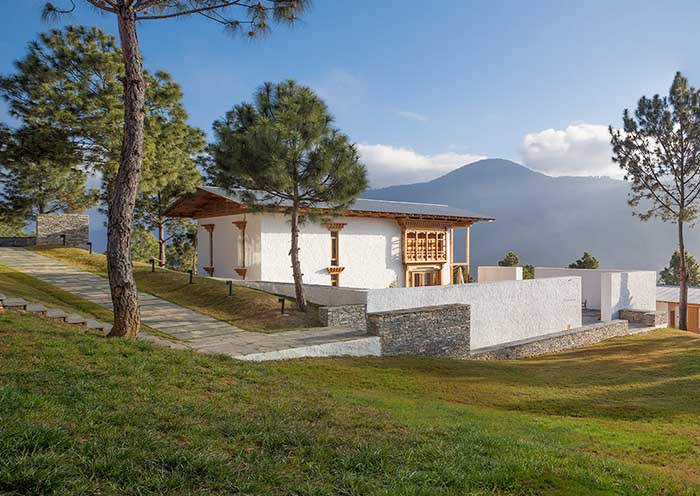
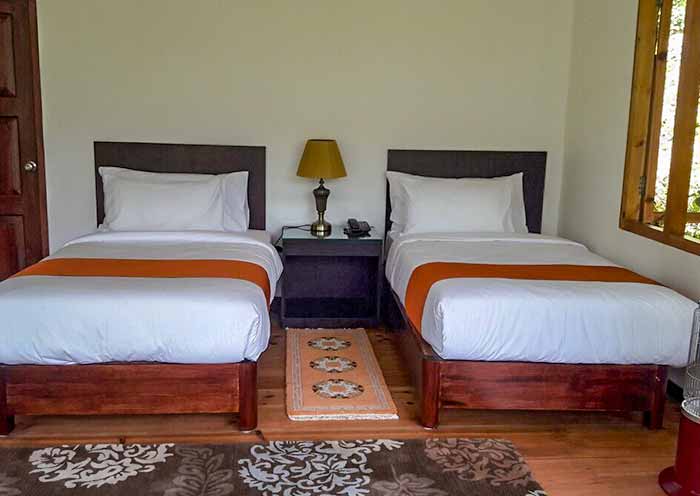
In Paro, Thimphu, Punakha and other destinations in Bhutan, there are several well-positioned 4-star hotels that offer convenient access to popular attractions and ensure a comfortable stay.
1. Upgrading Hotel Accommodation: If you desire a higher standard of accommodation, our travel experts can provide you with alternative pricing options for hotel upgrades. Whether you prefer a more luxurious experience or have specific preferences, the experts will assist you in making the best choice to suit your needs.
2. Check-In and Check-Out Times: Check-in time for the hotels is generally after 14:00 (2:00 PM), allowing you to settle in and freshen up before starting your Bhutanese adventure. On the day of departure, please check out before 12:00 noon to ensure a smooth transition and allow time for the hotel staff to prepare for incoming guests.
Photo Gallery for This Itinerary
Latest Bhutan Tours Reviews from Our Customers

cindy heng
Malaysia
Date of Experience: Sep 07, 2025
Tour Customized by: Abby
You May be Interested in This Tour: Customized Tour

mui m
Vietnam
Highly recommend Asia Odyssey - they planned a fantastic itinerary against our brief for Tibet, Nepal, and Bhutan. Special shoutout to Ms. Mandy who planned our trip, answered all our questions, was incredibly responsive, and was always helpful. She checked in during our trip to make sure we were okay as well. On our trip, our local guides were knowledgeable and kind and our accommodation was comfortable. All-in-all a fantastic experience and highly recommended.
Thank you for a wonderful experience!!
Destination(s): Tibet
Date of Experience: Jun 05, 2025
Tour Customized by: Mandy
You May be Interested in This Tour: Customized Tour

Bhawani Thangaratnam
Malaysia
Date of Experience: Aug 31, 2025
Tour Customized by: Steven
You May be Interested in This Tour: Customized Tour
Price: Request
(Based on a private tour for two people. Price varies depending on program, travel date, number of people.)
Free Enquiry! You don’t need to pay for the reservation.
- United States (+1)
- Australia (+61)
- Singapore (+65)
- Malaysia (+60)
- Philippines (+63)
- Canada (+1)
- Italy (+39)
- Indonesia (+62)
- United Kingdom (+44)
- Spain (+34)
- Mexico (+52)
- Hong Kong (+852)
- Thailand (+66)
- United Arab Emirates (+971)
- New Zealand (+64)
- South Africa (+27)
- Germany (+49)
- Brazil (+55)
- India (+91)
- France (+33)
- Vietnam (+84)
- The Netherlands (+31)
- Saudi Arabia (+966)
- Ireland (+353)
- Argentina (+54)
- Switzerland (+41)
- Romania (+40)
- Pakistan (+92)
- Japan (+81)
- Portugal (+351)
- Bangladesh (+880)
- South Korea (+82)
- Puerto Rico (+1)
- Türkiye (+90)
- China (+86)
- Belgium (+32)
- Qatar (+974)
- Greece (+30)
- Taiwan (+886)
- Austria (+43)
- Poland (+48)
- Israel (+972)
- Chile (+56)
- Sri Lanka (+94)
- Nigeria (+234)
- Peru (+51)
- Colombia (+57)
- Hungary (+36)
- Nepal (+977)
- Denmark (+45)
- Bulgaria (+359)
- Norway (+47)
- Slovenia (+383)
- Sweden (+46)
- Kuwait (+965)
- Costa Rica (+506)
- Ecuador (+593)
- Venezuela (+58)
- Malta (+356)
- Croatia (+385)
- Tunisia (+216)
- Czechia (+420)
- Mongolia (+976)
- Bahrain (+973)
- Mauritius (+230)
- Papua New Guinea (+675)
- Cambodia (+855)
- Dominican Republic (+1)
- Luxembourg (+352)
- Finland (+358)
- Guatemala (+502)
- Myanmar (+95)
- Maldives (+960)
- Slovakia (+421)
- Laos (+856)
- Serbia (+381)
- Brunei (+673)
- Oman (+968)
- Macao (+853)
- Panama (+507)
- Morocco (+212)
- Jordan (+962)
- Georgia (+995)
- Fiji (+679)
- Bolivia (+591)
- Lithuania (+370)
- Bahamas (+1)
- Cyprus (+357)
- Latvia (+371)
- Bhutan (+975)
- Iraq (+964)
- Iran (+98)
- Kenya (+254)
- Jamaica (+1)
- Zimbabwe (+263)
- Azerbaijan (+994)
- Uruguay (+598)
- Estonia (+372)
- Andorra (+376)
- Cameroon (+237)
- Ghana (+233)
- Kazakhstan (+7)
- Nicaragua (+505)
- Egypt (+20)
- Russia (+7)
- Albania (+355)
- Réunion (+262)
- Montenegro (+382)
- Algeria (+213)
- Afghanistan (+93)
- Martinique (+596)
- Uganda (+256)
- Honduras (+504)
- North Macedonia (+389)
- Trinidad and Tobago (+1)
- Suriname (+597)
- Antigua and Barbuda (+1)
- Zambia (+260)
- Ukraine (+380)
- Armenia (+374)
- Barbados (+1)
- Belarus (+375)
- Palestine (+970)
- Lesotho (+266)
- Moldova (+373)
- Ethiopia (+251)
- French Polynesia (+689)
- Gambia (+220)
- Guam (+1)
- Gibraltar (+350)
- Isle of Man (+44)
- New Caledonia (+687)
- El Salvador (+503)
- Comoros (+269)
- Seychelles (+248)
- Chad (+235)
- Samoa (+685)
- Cook Islands (+682)
- Palau (+680)
- Paraguay (+595)
- DR Congo (+243)
- Solomon Islands (+677)

